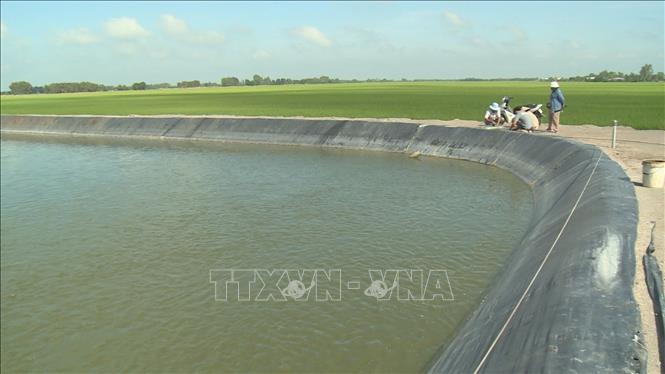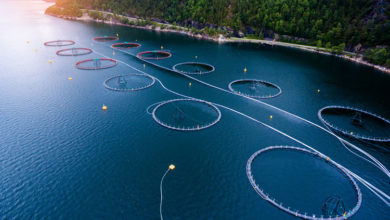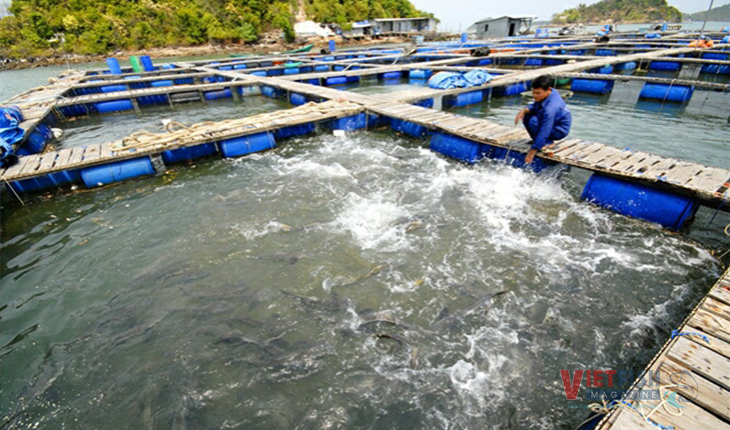Long An Farmers turn shrimp ponds into catfish havens
Many farmers in Long An province are transforming old shrimp ponds into productive aquaculture systems by integrating pangasius fry and naked catfishes (Mystus spp.) - a native catfish prized for its rich, sweet flesh.
A prized fish in decline sparks new opportunities
In the Mekong Delta, naked catfishes has long been a local favorite among freshwater species. However, wild stocks have dwindled in recent years due to environmental degradation and overfishing. As a result, naked catfishes has emerged as a specialty fish, commanding retail prices of VND 100,000 – 120,000 per kilogram, far higher than many other freshwater species. This growing market has inspired several farmers in Long An to begin farming naked catfishes commercially.
 Pangasius fish farming pond in the Đồng Tháp Mười region, Long An province. Photo: Released by Vietnam News Agency (TTXVN).”
Pangasius fish farming pond in the Đồng Tháp Mười region, Long An province. Photo: Released by Vietnam News Agency (TTXVN).”
The province features two main aquaculture zones: brackish-water farming in the southern districts of Tan Tru, Chau Thanh, and Can Duoc; and freshwater farming across the Dong Thap Muoi region, including Tan Thanh, Thanh Hoa, Moc Hoa, and Duc Hue. Many households have taken advantage of underutilized shrimp ponds by stocking pangasius fry and raising naked catfishes during the off-season.
Success stories from the field
Ta Van Vung, a farmer in Tan Thanh commune (Moc Hoa district), converted 2 out of his 5 hectares of former rice fields into naked catfishes ponds. After two years, he reports strong success. Traders pay between VND 80,000 – 100,000 per kilogram. With four ponds and a projected yield of 12 tons after four months, Vung expects to earn over VND 20,000 in profit per kilogram, well above the margins for other fish.
Similarly, Doan Van Huong of Nhut Ninh commune (Tan Tru district) has found integrated naked catfishes and black tiger shrimp farming to be an effective strategy. On his 9,000 m² plot, post-shrimp crops of naked catfishes have helped recover productivity in ponds previously plagued by disease and pollution. “Naked catfishes is a hardy species, requiring minimal technical input and performing well in both fresh and brackish water,” he said.
Huong added that the fish’s low labor requirements and resistance to disease make it an attractive option for local farmers. Currently sold exclusively on the domestic market, naked catfishes could become even more profitable with the right investment in export development.
Community initiatives driving momentum
Recognizing the potential of naked catfishes, local officials in Nhut Ninh are encouraging adoption. Out of 27 hectares of underperforming shrimp ponds, 17 households have already joined integrated farming programs. In April, the commune’s Farmers’ Association launched a naked catfishes cooperative with 12 members operating under the principle of voluntary, equal, and mutual benefit. The group supports each other in pond preparation, fry selection, feed management, and market access.
According to Nguyen Hoang Duc, head of the commune’s Farmers’ Association, each member has received a VND 50 million loan to scale up operations. The association has also requested that provincial authorities establish demonstration models to transfer technology and farming techniques more widely.
A sustainable path forward for aquaculture in Long An
With nearly 2,640 hectares under freshwater aquaculture, Long An is leveraging its natural advantages to build a more resilient and diverse farming base. As traditional species face declining interest or viability, naked catfishes has emerged as a promising alternative.
Le Thi Ngoc Hieu, Deputy Director of the Center for Technology Application and Information (under the Long An Department of Science and Technology), believes naked catfishes offers a high-margin economic solution for rural communities. Its adaptability to brackish water makes it an ideal candidate for integration into shrimp ponds. “Naked catfishes not only yields high profits but also plays a vital role in rejuvenating degraded pond ecosystems,” she noted.
VFM






